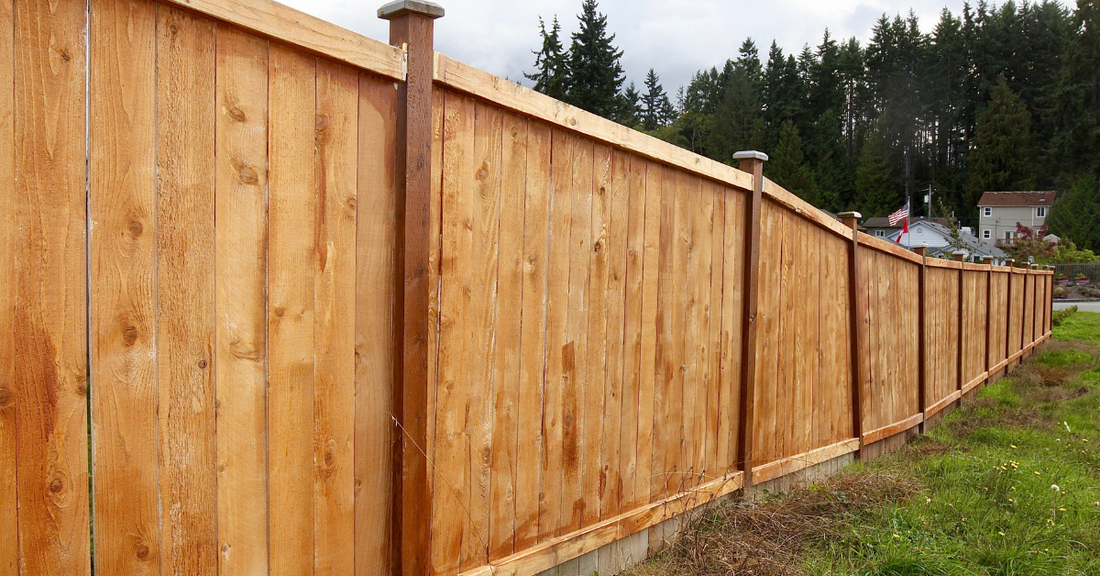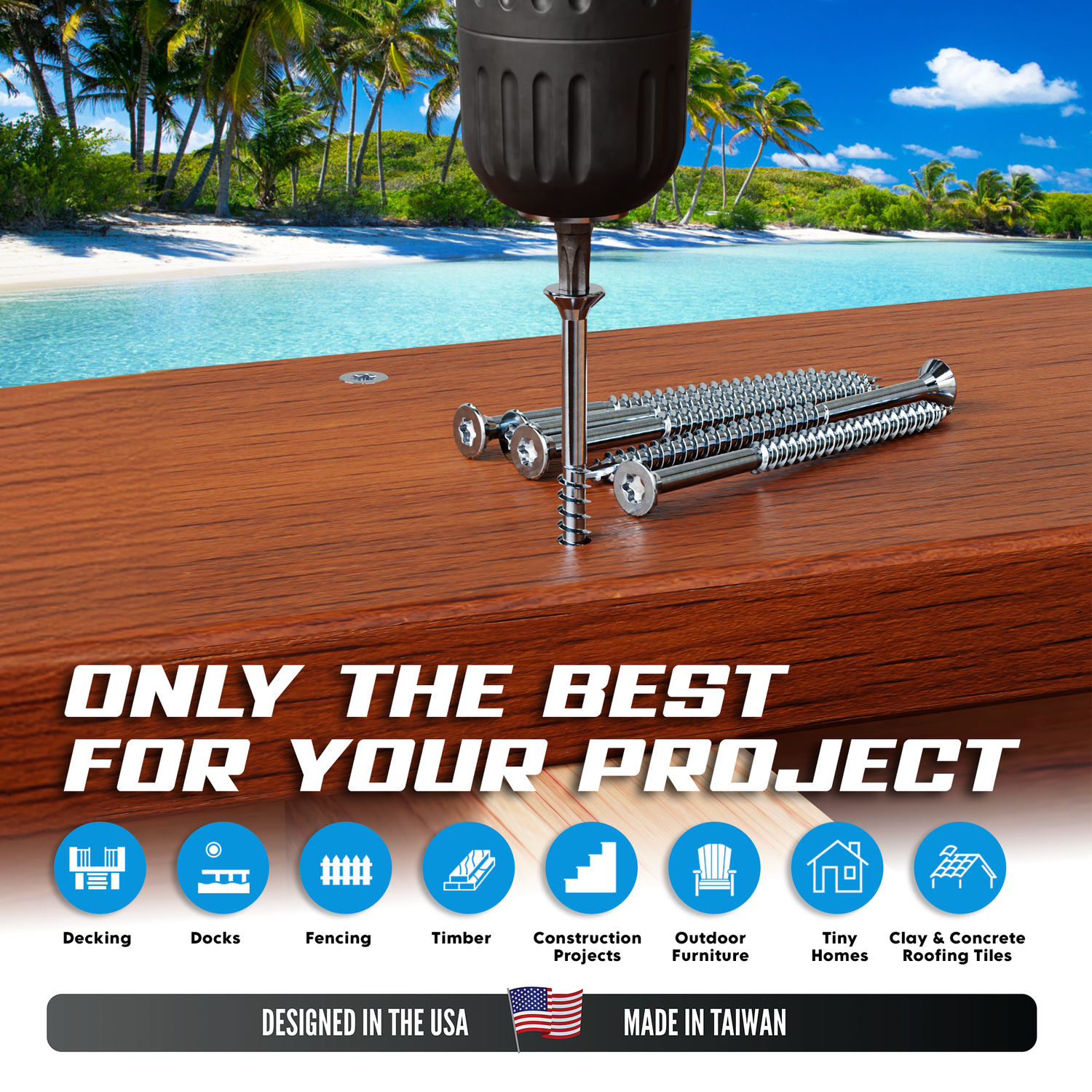
Building A Fence On Uneven Ground: Tips And Tricks
Share
Across most of the U.S., yards aren’t perfectly flat. Most yards slope away from the house. That simple fact changes how you build a fence on a slope: where posts go, whether you rack or step sections, and how you keep the top line clean without leaving pet-sized gaps at the bottom.
At Eagle Claw Fasteners, we’ve spent years building fences and other timber structures on tricky terrain. Here’s what we’ve learned to help you succeed when building a fence on uneven ground. But before we share the tips and tricks, there are a couple of questions that we need to address to build a fence on a slope.
TL;DR (How To Install A Fence On A Slope Like A Pro)
- The best fence for uneven ground is a raked fence. It doesn’t leave gaps between the bottom of the rail and the ground.
- Skip the pre-built panels from the big-box store. They can’t contour to your yard.
- Use screws for when building a fence on a slope. They perform relatively the same as ring shank nails when fastening fences, and you can easily remove them from the boards.
- Use cedar fence pickets for longevity. They are less likely to warp, twist, or cup than treated pine.
- Only use stainless steel screws, so your fasteners will last as long as your cedar fence.
Should a fence be level or follow the ground?
A fence should follow the ground. This means you need to build with the grade, adjusting the rails and post heights to flow with the dips and rises of the terrain.
What is the best fence for uneven ground?
The best fence for uneven ground is a raked fence, also known as a raked or racked fence. To do a fence on unlevel ground, you’ll either have to rack it or step it down. What makes raked fences better than stepped fences is that they leave no gaps between the bottom of the rail and the ground.

When to Build a Raked Fence
- When your slope is gentle, about a foot of rise over a 6-ft panel (or within your panel’s rack limit).
- When you want the bottom rail to hug the ground with minimal gaps for privacy. A raked fence keeps pets in and critters out.
- When you’re DIY-ing in wood. Stick-building rails and vertical pickets makes following the grade straightforward.
- When you want a smooth, flowing look that matches curves near ponds, lakes, or rolling terrain.
- When you’d like simpler, uniform-depth post holes, which can keep costs and complexity down.
- When privacy matters. Continuous ground contact usually blocks sightlines better than steps.
- When the slope doesn’t change abruptly, fast up-and-down sections are harder to rack cleanly.
When to Build a Stepped Fence
- When the grade is steeper or changes quickly along the run.
- When you want each panel level and don’t mind the tidy “stair-step” profile.
- When you’re in windy areas, the weight/load tends to be handled more evenly than with highly racked runs.
- When you’re okay managing triangular ground gaps (fill with soil/gravel or add a kickboard for pets).
- When you’re prepared to trim posts to different heights and accept a bit more installation time/cost.
Now that you know what type of fencing for slopes you’re building, here’s what you need to know about building a fence on uneven ground that looks good and costs less.
How to Build a Fence on a Slope the Way We Experts Do
A fence on unlevel ground is work, but it’s fairly simple to build. It’s difficult to do alone, but absolutely doable. Here’s how we do a fence installation on a slope every single time.

Use grade marks so posts “roll” with the ground.
Before you set posts, put two simple marks on each one: 12" down from the top (a reference) and 6' down from the top (your grade mark for a 6' fence).
As you set them, sight across those marks and keep them lined up so the fence naturally follows the slope. If that 6' mark disappears below the soil, you know you’re digging deeper there.
When the terrain drops, spread that drop evenly over the next post or two so the line rolls smoothly instead of going drop–flat–drop. And anytime you tug a post to adjust it, recheck that it’s back in line with the run.
Sight a straight line over a hill.
Mark both property corners with T-posts, then set two stakes on the hill and look down them like sights until both stakes point to both corners. When all four points line up, pull a string or a light wire and use that as your straight reference before you set posts and rails.
Keep post depth and exposure consistent.
Pick a target and stick to it; for example, bury 30" of an 8' post so about 5'6" is exposed. Uniform exposure keeps your finished height consistent and helps the fence roll with the grade without sudden jumps.
Leave posts tall, then set the top with a string.
Use longer posts, set them to full depth, and run a tight string across the tops to visualize the finished line. Step back, nudge the string up or down where needed, then trim posts to that line so the top looks intentional even on uneven ground.
When the terrain only rises a little, feather the top line.
Start by marking every post at a consistent baseline, then go plus or minus an inch or two post-to-post to smooth out the little humps. Mark it out, step back, and make those tiny adjustments as you go.
Don’t buy pre-built fence panels.
Skip the pre-built panels from the big-box store. They can’t contour to your yard, so the run ends up looking stair-stepped. It’s never a great look and definitely not custom to the space. Build a fence on unlevel ground on-site instead, so the fence can follow whatever terrain your yard has.
Join rails at the center of each post.
Cut rails so every joint lands at the center of a post. This keeps angle transitions clean on racked runs and makes each bay stronger from post to post.
Let the bottom rail follow the ground (about 6" up).
Run the bottom rail roughly 6" above the ground and actually follow the grade as it rises or falls. Do not leave the rail high and then set pickets to it. When the ground drops, let the rail drop with it so gaps do not open under the fence.

Use the 6" reveal rule on pickets.
Aim for about 6" of picket above the top rail and about 6" below the bottom rail. Too much reveal looks odd and warps faster, and too little shows the rails and breaks the visual line.
Use a string at the picket tops.
Tack a temporary picket at changes in grade, run a string across their tops, and set picket tops to that line. This keeps the silhouette smooth and helps the fence flow with the yard instead of fighting it.
Building the best gate for uneven ground
Measure your gate along the grade, not level.
On a slope, hook your tape at the inside face where the ground meets the high post, then pull it along the ground to the inside face where the ground meets the low post and record that inside-to-inside distance. In real life this can be 93" along the grade, while a lazy level pull reads only 85½", which will leave your gate frame short.
Loop a string around the bottoms of both posts, add a small line level, and adjust the string until it reads level. Measure from the string down to the ground at the low side to get the exact drop you need to build into the gate. Use that slope measurement, plus your hinge and latch takeoffs and the width of your frame material, so the gate fits the opening and swings without hitting the ground.
Gate setup on mild slopes: match the top rails.
Building a gate on a sloped wood fence is challenging. It’s the number one reason for callbacks in the US.
When there’s only a slight rise, with one rail a bit lower than the other, hang the gate so its top rail aligns with the fence’s top rail. That might make the gate side slightly taller than the lower fence rail, and that’s fine.
If the grade is extreme, you should custom-build the gate to follow the drop. Since the slope is mild, a square-frame gate works; just match the top of the gate rail to the fence rail.
Choose cedar over treated pine.
There are a few solid reasons your next wood fence should be built with cedar instead of treated pine.
First is availability. Whether it is a pandemic or hurricane season, cedar is more readily available throughout the year, so you can build when you are ready.
Second is longevity. Cedar has naturally occurring oils that repel rot and insects.
Third is appearance. Cedar boards are unique; no two are the same. Your fence will have a rustic appearance since cedar is usually rough-sawn, and it will age to a silver color instead of a dark gray.
Finally, cedar stays straighter compared to pressure-treated wood. It’s not as likely to warp, twist, or cup because it dries more evenly
Use stainless steel screws on cedar.
Since you’re building a cedar fence, use stainless steel screws to avoid streaks. The tannic acids in cedar can react with regular fasteners and leave that stain all the way down the fence, so make sure you use stainless steel.

But why screws over nails when building a fence on uneven ground? Screws can be easily removed, which helps with removable panels or repair, while ring shank nails are great for production but are harder to pull without splitting a picket.
Screws often perform relatively the same as ring shank nails when it comes to holding pickets to rails and rails to posts. Keep your driver from over-torquing so the head-to-shaft area does not fail.
Quality Stainless Steel Wood Screws for Fencing for Slopes from Eagle Claw Fasteners
On sloped runs, layout gets you straight, and stainless keeps you stain-free. Your wood fence fasteners should last as long as your cedar pickets, and Eagle Claw stainless steel fencing screws are built by contractors who’ve spent years in outdoor timber work. The quality holds its own against the big names, while the value makes sense when you’re building every day.
Many professional fencers continue to trust Eagle Claw for their slope installs, and they receive exclusive offers, practical tips, and a standing discount on every order.
Join the Eagle Claw Pro List: get 10% off every order when you sign up, plus member-only deals and jobsite tips that help you work faster and avoid callbacks.
FAQs
How to install fence panels at odd angles?
If your corner is close to 90 degrees, just attach the rails like normal—there’s enough wiggle room to make it look clean. If it’s way off 90 degrees, you’ve got two options: set a double-post corner so each panel lands on its own post face, or bevel/notch the corner post so the rails catch at the angle you need.
Can a vinyl fence be installed on uneven ground?
Yes, a vinyl fence can be installed on uneven ground: plan for consistent post heights that follow the grade, measure spans along the slope (not level) to size sections, use rails cut to match the slope angle, and account for your system type (no-dig metal posts vs. routed vinyl) when sizing parts.


